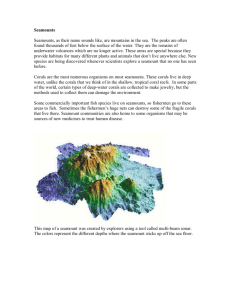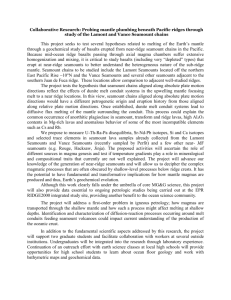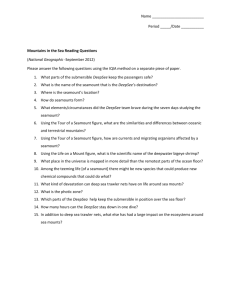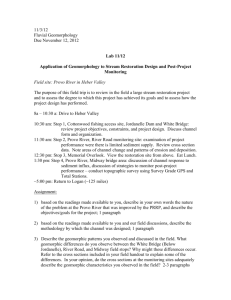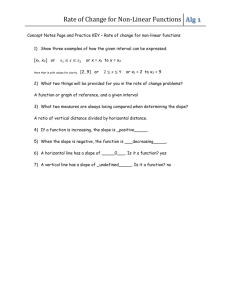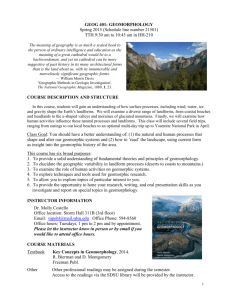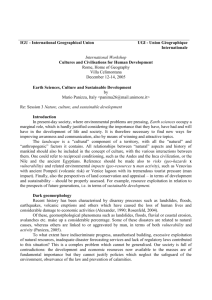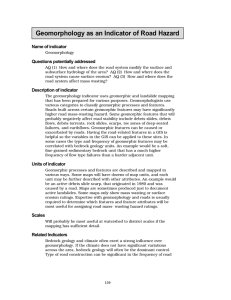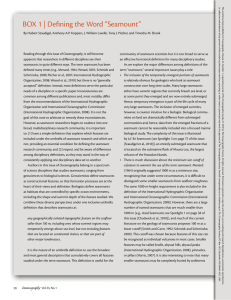ddi12069-sup-0002-AppendixS2
advertisement
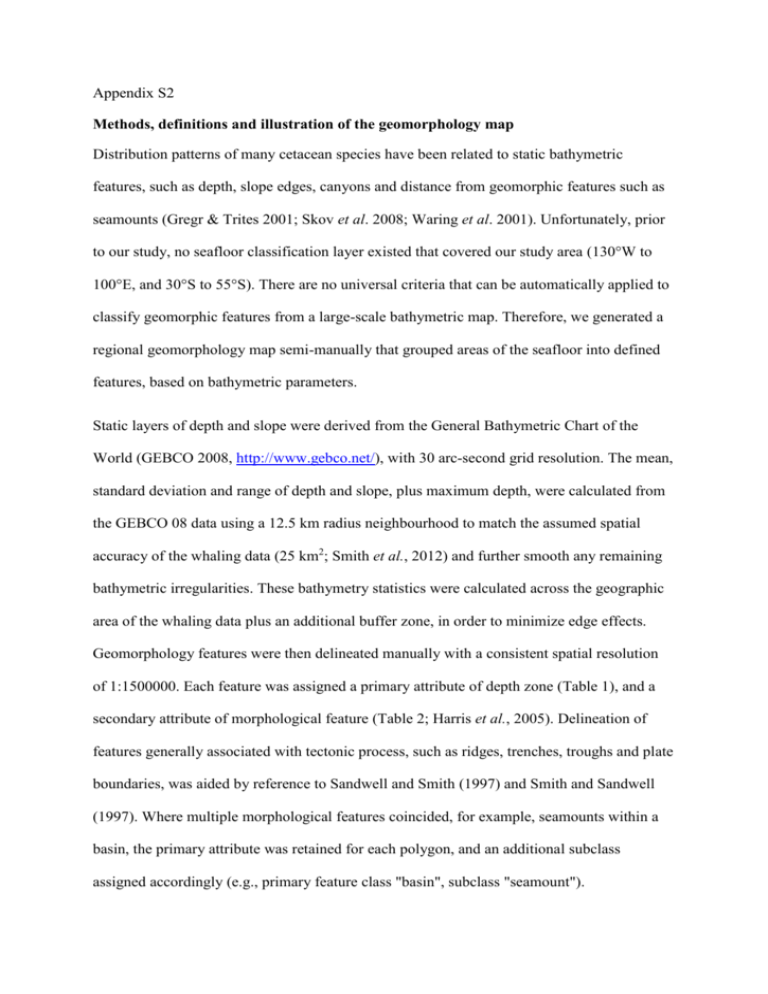
Appendix S2 Methods, definitions and illustration of the geomorphology map Distribution patterns of many cetacean species have been related to static bathymetric features, such as depth, slope edges, canyons and distance from geomorphic features such as seamounts (Gregr & Trites 2001; Skov et al. 2008; Waring et al. 2001). Unfortunately, prior to our study, no seafloor classification layer existed that covered our study area (130°W to 100°E, and 30°S to 55°S). There are no universal criteria that can be automatically applied to classify geomorphic features from a large-scale bathymetric map. Therefore, we generated a regional geomorphology map semi-manually that grouped areas of the seafloor into defined features, based on bathymetric parameters. Static layers of depth and slope were derived from the General Bathymetric Chart of the World (GEBCO 2008, http://www.gebco.net/), with 30 arc-second grid resolution. The mean, standard deviation and range of depth and slope, plus maximum depth, were calculated from the GEBCO 08 data using a 12.5 km radius neighbourhood to match the assumed spatial accuracy of the whaling data (25 km2; Smith et al., 2012) and further smooth any remaining bathymetric irregularities. These bathymetry statistics were calculated across the geographic area of the whaling data plus an additional buffer zone, in order to minimize edge effects. Geomorphology features were then delineated manually with a consistent spatial resolution of 1:1500000. Each feature was assigned a primary attribute of depth zone (Table 1), and a secondary attribute of morphological feature (Table 2; Harris et al., 2005). Delineation of features generally associated with tectonic process, such as ridges, trenches, troughs and plate boundaries, was aided by reference to Sandwell and Smith (1997) and Smith and Sandwell (1997). Where multiple morphological features coincided, for example, seamounts within a basin, the primary attribute was retained for each polygon, and an additional subclass assigned accordingly (e.g., primary feature class "basin", subclass "seamount"). A global layer of seamount location and base layer size was obtained from Yesson et al. (2011) that computationally derived these features from a global 30 second (~1 km) bathymetry grid. Seamounts are a dominant feature in many areas of the Australasian region and have been previously associated with the distribution of whales (Waring et al., 2001; Skov et al., 2008). The base areas of seamounts were merged so that overlapping seamount features became a single polygon. These features were clipped into the overall geomorphology feature layer to produce a final map of geomorphology within the Australasian region (Fig. 1), which is a first of its kind, highly informative and useful for many scientific applications. The following feature classes are defined: shelf, slope, rise, plain, valley, trench, trough, basin, hills(s), mountains(s), ridges(s), plateau, seamount. Literature Cited Harris, P., Heap, A., Passlow, V., Shaffi, L., Fellows, M., Porter-Smith, R., Buchanan, C. & Daniell, J. (2005) Geomorphic features of the continental margin of Australia. In: Geoscience Australia Record 2003/30, p. 142. Geoscience Australia, Canberra. Sandwell, D.T. & Smith, W.H.F. (1997) Marine gravity anomaly from Geosat and ERS 1 satellite altimetry. Journal of Geophysical Research-Solid Earth, 102, 10039-10054. Skov, H., Gunnlaugsson, T., Budgell, W.P., Horne, J., Nottestad, L., Olsen, E., Soiland, H., Vikingsson, G. & Waring, G. (2008) Small-scale spatial variability of sperm and sei whales in relation to oceanographic and topographic features along the Mid-Atlantic Ridge. Deep-Sea Research Part II-Topical Studies in Oceanography, 55, 254-268. Smith, T.D., Reeves, R.R., Josephson, E.A. & Lund, J.N. (2012) Spatial and seasonal distribution of American whaling and whales in the age of sail. PLoS ONE, 7, e34905. Smith, W.H.F. & Sandwell, D.T. (1997) Global sea floor topography from satellite altimetry and ship depth soundings. Science, 277, 1956-1962. Waring, G.T., Hamazaki, T., Sheehan, D., Wood, G. & Baker, S. (2001) Characterization of beaked whale (Ziphiidae) and sperm whale (Physeter macrocephalus) summer habitat in shelf-edge and deeper waters off the northeast US. Marine Mammal Science, 17, 703-717. Yesson, C., Clark, M.R., Taylor, M.L. & Rogers, A.D. (2011) The global distribution of seamounts based on 30 arc seconds bathymetry data. Deep Sea Research Part I: Oceanographic Research Papers, 58, 442-453. Table 1. Definitions of depth zones used as primary classifications for the geomorphology map. Zone name Hadalpelagic Depth range (m) > 6,000 Abyssopelagic > 4,000 and < 6,000 Bathypelagic > 1,000 and < 4,000 Mesopelagic > 200 and < 1,000 Epipelagic < 200 Table Error! No text of specified style in document.. Definitions of 13 geomorphic feature classes, derived from Harris et al. (2005), applied to create the geomorphology map. Geomorphic Class Description Shelf Zone adjacent to a continent, or around an island, and extending from the low water line to a depth at which there is a marked increase toward oceanic depths. Slope Seaward from the shelf edge to the upper edge of a continental rise, or the point where there is a general reduction in slope. Rise Gentle slope rising from the ocean depths toward the foot of a continental slope. Plain (including abyssal plain) Extensive, flat, gently sloping or nearly level region at abyssal depths. Valley Relatively shallow, wide depression, the bottom of which usually has a continuous gradient. This term is generally not used for features which have canyon-like characteristics for the majority of their extent. Trench Long, narrow, characteristically very deep and asymmetrical depression of the sea floor, with relatively steep sides. Trough Long depression of the sea floor, characteristically flat-bottomed and steep-sided and normally shallower than a trench. Basin Depression, characteristically in the deep sea floor, more or less equidimensional in plan and of variable extent. Hill(s) Relatively small, isolated elevation. Mountain(s) Large and complex grouping of ridges and seamounts. Ridge(s) Long, narrow elevation with steep sides; or long, narrow elevation separating ocean basins; or a linked, major oceanic mountain system of global extent. Plateau Flat or nearly flat area of considerable extent, dropping off abruptly on one or more sides. Seamount Large isolated elevation above the sea floor, characteristically of conical form. Derived from Yesson et al. (2011). Figure 1. Geomorphology map of the Australasian region produced for this study, with boundaries of the eastern and western regions demarcated by black lines. Seamount base area layer provided by Yesson et al. (2011).

